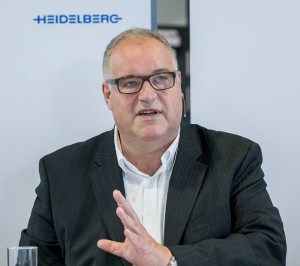Heidelberg has recorded a $145.3m loss in the first three quarters of the financial year 2014/2015, but the company remains optimistic saying it will achieve an EBITDA margin of eight per cent target in 2015-16.
The company blames a significant decline in China sales, no different to other press manufacturers, and huge restructuring costs for its loss in just nine months. However, the one-time giant hopes to make strong sales in the final quarter of this financial year, which it predicts will diminish the annual fall in sales to five per cent, compared to the 7.8 per cent fall in the first nine months of the previous year.
Richard Timson, managing director for Heidelberg ANZ, says, “While compared to last year, the sales will be down, which is in line with expectations in a consolidating print market, and while consumables and servicing are under pressure, Heidelberg ANZ has sold more presses compared to same time last year. Several orders are still being shipped and processed.
“We are hanging in there here, and have sold more equipment than expected, especially a lot more A2 presses compared to A1, which means more revenue.”
Incoming orders for the global company rose in Q3, but were down overall for the nine months. The $145.3m loss is more than double the $61.3m loss of the first nine months of last year, but $110m of that was in now-completed restructuring costs.
Gerold Linzbach, chief executive at Heidelberg, says, “The main focal point in the current financial year is to realign the portfolio so as to place Heidelberg on a sustainably profitable footing. We have geared our portfolio toward profitability and growth and adjusted resources accordingly. I am confident that our strategic restructuring will enable us to achieve and maintain our target margin from next financial year onward and return to growth in the future.”
Despite the loss, Heidelberg managed to pay down some debt. It cut staff numbers by 600 from 12,851 plus 621 trainees to 12,280 plus 534 trainees. The company has also confirmed its plans to continue reducing low-margin business, such as its withdrawal from most of the finishing market, and will stop production of the GTO.



